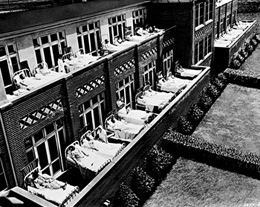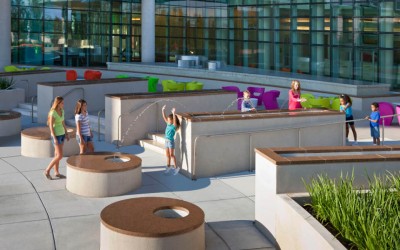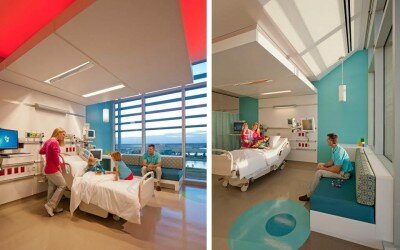How important is natural sunlight to the recovery of hospital patients?

In short, very.
Florence Nightingale, in 1863, first wrote about the benefits of daylight to patients in her Notes on Hospitals. She stated that “the axis of a ward should be as nearly as possible north and south; the windows on both sides, so that the sun shall shine in (from the time he rises till the time he sets) at one side or the other. There should be a window to at least every two beds, as is the case now in our best hospitals.” (pg. 19) Even back then the prevailing mindset was that patients need daylight and a vista to reduce their length of stay because the body and mind function best in an environment where the sun and daylight are present.

TB patients receive heliotherapy in Sanatorium
Mounting evidence suggests the same.
During the devastating TB outbreaks of the last century patients were often wheeled out onto terraces in the day to sit or lie in direct sunlight (heliotherapy)- TB bacteria die in direct sunlight. With the advent of antibiotics, however, this treatment fell into disuse but healthcare professionals, more and more, are incorporating natural light back into modern hospital designs to enhance their patient’s experience and speed the recovery process.
A 2001 study by Benedetti et al found that patients hospitalized for depression stayed an average of 3.7 fewer days if they were assigned east-facing rooms exposed to morning light, compared to patients in west-facing rooms with less sunlight (vii). Depression is a serious problem not only for mental health patients, but also for patients with cardiovascular disease or cancer. A Canadian investigation of myocardial infarction patients suggested that female patients had shorter stays if their rooms were sited to provide higher daylight exposure (viii). In the same study, mortality in both sexes was lower in sunnier rooms than in north-facing rooms.”
It is also known that the efficacy of certain cancer medicines depend on what time of day they are administered because of seratonin & melatonin levels in the blood. These hormones are regulated by sunlight and affect regulatory mechanisms in the body.
Stanley Beaman & Sears’ Nemours Children’s Hospital project* in Orlando, Florida is a built example of these principles and a flagship example of evidence based design (EBD) – which is popular in healthcare architecture in an effort to improve patient and staff well-being, patient healing, and stress reduction.
Nemours’ interior spaces actually strategically harvest daylight and the floor to ceiling windows provide patients with garden views. Lounges and playrooms give access to outdoor spaces for respite and active recreation. The campus allows children and adults to discover the wonders of nature that stimulate the senses and inspire holistic healing. The physical connection to the outdoors greatly enhances the effectiveness of this leading healthcare facility.

Nemours Children’s Hospital Sunlit Chapel and Family Room

Nemours Children’s Hospital Water Feature
To read more on Evidence Based Design and the power of natural light, check out the following links:
The Future of Evidence Based Design
, internationally renowned mind body researcher and author of Healing Spaces: The Science of Place and Well-Being
Download Florence Nightingale’s book free on Google Play
* A large team supported the design of the Nemours Children’s Hospital, including patient-care-team consultants Bowen & Briggs, associate architects for hospital interior design Perkins +Will, landscape designers AECOM (formally Glatting Jackson), civil engineers Harris Civil Engineering, structural engineers Simpson Gumpertz & Heger, mechanical electrical plumbing, technology, audio/visual and fire protection consultants TLC Engineering for Architecture, lighting designers CD+M, medical equipment planners Source Atlantic, security consultants HSJ, kitchen design consultant SDI, elevator consultant Lerch Bates and fountain consultant ADE.
By: Amy Blanco

